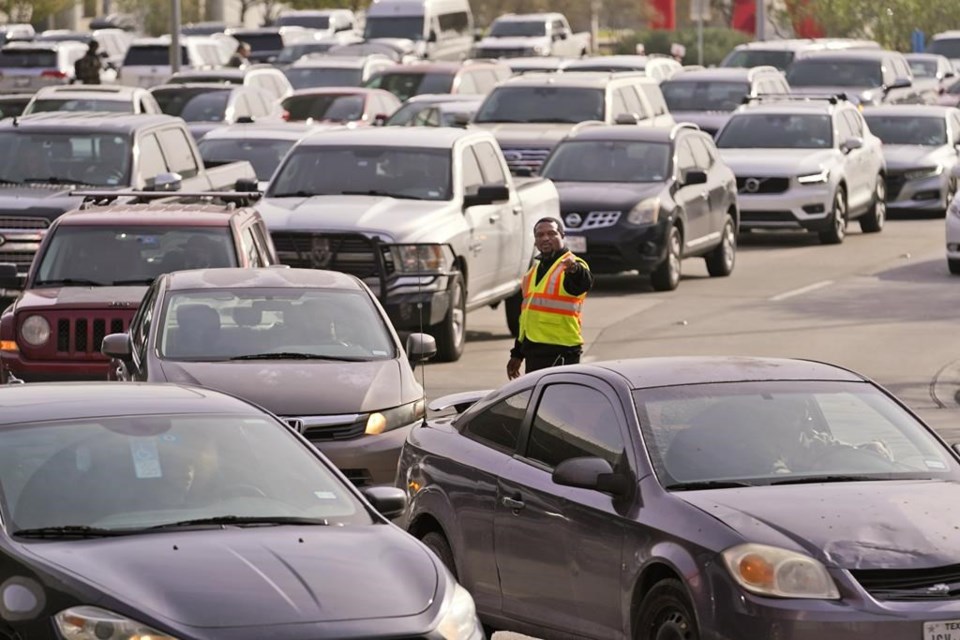ORLANDO, Fla. (AP) — If you think U.S. roads have gotten busier on your morning commute, you're not alone.
The rate of workers driving to their jobs creeped upwards nationwide last year, as did those who carpool to work by car, truck or van. The mean commuting time jumped by almost a minute in 2022 from the previous year, as more businesses ended full-time remote work, a sign that post-pandemic life edged closer in 2022 to what it was before COVID-19.
The rate of people working from home dropped from almost 18% in 2021 to 15.2% in 2022, according to new survey data on life in America released Thursday by the U.S. Census Bureau. The survey covers commuting times, internet access, family life, income, education levels, disabilities, military service, and employment, among other topics.
Mark Behrens, a human resources data analyst in Orlando working for a Fortune 500 company, started driving to his office in March 2022 after working from home for two years because of the pandemic. Managers now require employees to spend at least three days a week in the office. While most of his co-workers resented the order, Behrens was elated to see the in-person collaboration with his colleagues return to something that felt closer to normal.
“The advantage of coming into the office, even if it’s only hybrid, is not being isolated, having some social connections,” Behrens said. “You see people and you mention something you are working on and you start to talk about it more, and you can come up with more solutions, and make more progress.”
The rate of people commuting to work alone in a vehicle climbed from 67.8% in 2021 to 68.7% in 2022, and it went from 7.8% to 8.6% for carpoolers. Public transportation usage rose from 2.5% to 3.1% year-over-year, and the time people spent traveling to work jumped almost a full minute to 26.4 minutes in 2022 compared to 25.6 minutes in 2021, according to the American Community Survey's 1-year estimates.
Despite the significant decline in working remotely from 2021 to 2022, it still was almost three times higher than before the pandemic in 2019, when it was only 5.7% and more than three-quarters of workers drove alone to work in a vehicle. The 2022 survey did not let participants say whether they work from home full-time or only some of the time.
Even though there were advantages to working from home, like throwing something into the crock pot during lunch breaks, Allison Graves was happy to return to her first-grade classroom after teaching virtually for most of the first two years of the pandemic, which started in early 2020. With a renewed commute, she could catch up on podcasts she missed because she didn't spend so much time in her car.
“Continuing virtually just wasn’t the same as teaching face-to-face,” said Graves, who lives in Virginia Beach, Virginia. “People spent much of 2020 and 2021 not going places, and now people are expected to be back or doing hybrid."
Earlier this week, the Census Bureau released national data on income, poverty and the rate of people without health insurance. American Community Survey data released Thursday showed what those rates were broken down by states and smaller geographies.
The District of Columbia and New Jersey had the highest median household income with $101,027 and $96,346, respectively, compared to more than $74,000 nationally. Mississippi's $52,719 was the lowest of any state.
The rate of those lacking health insurance was lowest in Massachusetts and the District of Columbia, respectively 2.4% and 2.9%, compared to the national average of 8%. It was highest in Texas at 16.6%.
Fewer people moved in 2022 compared to 2021, and the presence of a child in a household also dropped slightly. The average household size trended lower, going from 2.54 to 2.5 people, as did the average family size, going from 3.15 to 3.11 people.
The foreign born population inched up slightly to 13.9%, and the rate of people who spoke only English at home dropped slightly from the previous year to 78% in 2022.
Even though the back-in-office-three-days-a-week work schedule was mandated for Behrens' office in 2022, few co-workers followed it, so his company decided not to renew its Orlando office lease. Now all 100 office employees will be working from home, something Behrens isn't looking forward to when it starts at the end of the month.
“I won't get to see anybody,” Behrens said. “It's not ideal for me, though most people have no problem with this, whatsoever, and love it and don’t miss the commute.”
___
Follow Mike Schneider on X, formerly known as Twitter: @MikeSchneiderAP.
Mike Schneider, The Associated Press



